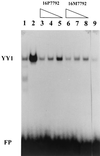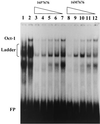Variable oncogene promoter activity of human papillomavirus type 16 cervical cancer isolates from Australia
- PMID: 11326037
- PMCID: PMC88072
- DOI: 10.1128/JCM.39.5.2009-2014.2001
Variable oncogene promoter activity of human papillomavirus type 16 cervical cancer isolates from Australia
Abstract
The functional significance of sequence variation within the upstream regulatory region (URR) of six human papillomavirus type 16 (HPV16) cervical cancer isolates from Australia was investigated. Specific changes in transcription factor binding sites leading to increased promoter activity may explain the transforming ability of some episomal HPV16 isolates.
Figures




Similar articles
-
Suppression of tumorigenesis by transcription units expressing the antisense E6 and E7 messenger RNA (mRNA) for the transforming proteins of the human papilloma virus and the sense mRNA for the retinoblastoma gene in cervical carcinoma cells.Cancer Gene Ther. 1995 Mar;2(1):19-32. Cancer Gene Ther. 1995. PMID: 7621252
-
Variants of the long control region and the E6 oncogene in European human papillomavirus type 16 isolates: implications for cervical disease.Br J Cancer. 2002 Jan 21;86(2):269-73. doi: 10.1038/sj.bjc.6600024. Br J Cancer. 2002. PMID: 11870518 Free PMC article.
-
Sequence variation and physical state of human papillomavirus type 16 cervical cancer isolates from Australia and New Caledonia.Int J Cancer. 2002 Feb 20;97(6):868-74. doi: 10.1002/ijc.10103. Int J Cancer. 2002. PMID: 11857370
-
[Possible role of transcription factor AP1 in the tissue-specific regulation of human papillomavirus].Rev Invest Clin. 2002 May-Jun;54(3):231-42. Rev Invest Clin. 2002. PMID: 12183893 Review. Spanish.
-
[Human papillomaviruses].Nihon Rinsho. 2003 Mar;61 Suppl 3:562-7. Nihon Rinsho. 2003. PMID: 12718029 Review. Japanese. No abstract available.
Cited by
-
Guidelines of the Italian Society for Virology on HPV testing and vaccination for cervical cancer prevention.Infect Agent Cancer. 2008 Dec 16;3:14. doi: 10.1186/1750-9378-3-14. Infect Agent Cancer. 2008. PMID: 19087272 Free PMC article.
-
hpvPDB: An Online Proteome Reserve for Human Papillomavirus.Genomics Inform. 2013 Dec;11(4):289-91. doi: 10.5808/GI.2013.11.4.289. Epub 2013 Dec 31. Genomics Inform. 2013. PMID: 24465243 Free PMC article.
-
HPV infections and tonsillar carcinoma.J Clin Pathol. 2004 May;57(5):449-55. doi: 10.1136/jcp.2003.008656. J Clin Pathol. 2004. PMID: 15113849 Free PMC article. Review.
-
Sequence variation in the E2-binding domain of HPV16 and biological function evaluation in Tunisian cervical cancers.Biomed Res Int. 2014;2014:639321. doi: 10.1155/2014/639321. Epub 2014 Jun 17. Biomed Res Int. 2014. PMID: 25032221 Free PMC article.
-
HPV & head and neck cancer: a descriptive update.Head Neck Oncol. 2009 Oct 14;1:36. doi: 10.1186/1758-3284-1-36. Head Neck Oncol. 2009. PMID: 19828033 Free PMC article. Review.
References
-
- Ausubel F M, Brent R, Kingston R E, Moore D D, Seidman J G, Smith J A, Struhl K. Short protocols in molecular biology. 2nd ed. New York, N.Y: John Wiley & Sons, Inc.; 1992.
-
- Chan S,-Y, Ho L, Ong C K, Chow V, Drescher B, Durst M J, ter Meuler J, Villa L L, Luande J, Mgaya H N, Bernard H U. Molecular variants of human papillomavirus-16 from four continents suggest ancient pandemic spread of the virus and its coevolution with humankind. J Virol. 1992;66:2057–2066. - PMC - PubMed
-
- Das B C, Sharma J K, Gopalakrishna V, Luthra U K. Analysis by polymerase chain reaction of the physical state of human papillomavirus type 16 DNA in cervical preneoplastic and neoplastic lesions. J Gen Virol. 1992;73:2327–2336. - PubMed
-
- Dong X P, Stubenrauch F, Beyer-Finkler E, Pfister H. Prevalence of deletions of YY1-binding sites in episomal HPV 16 DNA from cervical cancers. Int J Cancer. 1994;58:803–808. - PubMed
Publication types
MeSH terms
Substances
LinkOut - more resources
Full Text Sources
Medical

